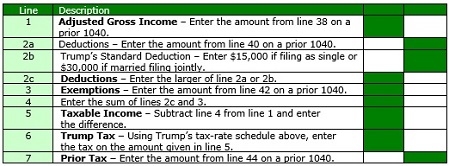WHAT DOES THE FUTURE HOLD FOR TAXES?
On December 22, 2017, The Tax Cuts and Jobs Act was signed into law. The information in this article predates the tax reform legislation and may not apply to tax returns starting in the 2018 tax year. You may wish to speak to your tax advisor about the latest tax law. This publication is provided for your convenience and does not constitute legal advice. This publication is protected by copyright.

Article Highlights:
- Trump’s Proposed Tax Policies
- Consolidated Tax Rates
- Increased Standard Deductions
- Comparison Worksheet
- Other Factors
One topic that is frequently being discussed is what the future holds for individual taxation under President Trump. Numerous blog entries have been posted on the issue; many proclaim that the wealthy will be the beneficiaries of Trump’s tax policies, and some declare that lower-income taxpayers will see tax increases.
Those predictions are based upon his proposal to consolidate the individual income tax rates from seven to three: 12, 25 and 33 percent. These are the same three rates that were included in the “Better Way” tax-reform blueprint that Republicans in the House of Representatives released in June 2016.


Under Trump’s plan, the two highest current rates, 39.6% and 35%, would be eliminated, which generally favors higher-income taxpayers. However, the tax brackets alone do not tell the whole story.
Trump is also proposing more than doubling the standard deductions, which would generally benefit lower-income taxpayers. Because the marginal tax rates apply only to taxable income (which is currently defined as adjusted gross income minus personal exemptions and deductions—either standard or itemized), the increase in the standard deduction will tend to neutralize the higher marginal rates for lower-income taxpayers.

According to an estimate by the nonpartisan Tax Policy Center, of the 45 million filers who would itemize their deductions in 2017, 27 million (60 percent) would opt for the standard deduction under the proposed rules.
To see how the proposal’s combination of new tax rates, higher standard deductions, and cap on itemized deductions (discussed below) could affect your taxes, pull out your 1040 tax return from either 2015 or 2016 and complete the worksheet below. Then compare line 6 (your tax computed using Trump’s proposed three-tier tax rates and standard deductions) to line 7 (your tax as computed on a prior 1040) to get a rough idea of how these tax proposals could impact you.



Trump also proposes capping itemized deductions at $100,000 for single filers and $200,000 for joint filers. This will generally affect wealthy taxpayers. Under current law, certain itemized deductions phase out for high-income taxpayers. It is unclear whether that provision will be replaced by the proposed cap on itemized deductions or whether both will apply. If the cap is adopted, the amount entered on line 2c of the worksheet above will be limited based on the proposed cap amounts.
Although this is not clear, Trump’s proposals may include the elimination of personal exemptions. If true, this change would have the greatest effect on lower-income taxpayers because these exemptions are already phased-out for higher-income taxpayers. Those with large families could be impacted the most. If the personal exemptions are eliminated, the amount on line 3 of the worksheet above would be zero.
Not the Whole Picture – The tax-rate changes, higher standard deductions, and limitations on itemized deductions don’t paint the whole picture of the proposal. It is unclear what will happen to the numerous credits available to lower-income taxpayers under the current tax system. Approximately 48% of all U.S. taxpayers pay no tax at all, and most of them actually receive money back on their returns as a result of refundable tax credits such as the earned income tax credit, the additional child tax credit, and the American Opportunity Tax Credit (a tuition credit).
The Republicans have started the process of repealing the Affordable Care Act (also referred to as the ACA or Obamacare), and now that they have majorities in both houses of Congress and control of the White House, we are bound to see some changes in this area. The health care marketplaces have already accepted insurance coverage for 2017, so it is doubtful that there will be any changes until 2018. However, Trump has vowed to overturn the ACA’s 3.8% excise tax on net investment income; eliminating this tax would greatly benefit higher-income taxpayers.
It is probably too early to have a clear picture of future tax reforms, but change is sure to come. If you have questions about how your tax situation may be impacted, please give this office a call.








Leave a Reply
Want to join the discussion?Feel free to contribute!